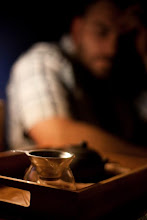It's been 3-4 years that I've been sticking to one kind of water for every family of tea I drink. This water is extremely low on minerals (about 50mg/l). The aim of this exercice is to develop my palate, so that the only thing that changes from one session to another (than I can control anyway) is the tea itself, in an attempt to try and spot its qualities and defects. Trying to do so is not an easy thing to do by oneself for sure, and I should have done way more side by side tastings and water exercises too. But some among you might have an idea of what a teaaddict's life is like : there are always at least a dozen samples to drink, try to taste all there is to taste, barring the really suspicious sources of course...
I don't think that it has been a bad thing. And anyway, I have a scientific mind, I can absolutely not change more than one parameter at a time. To give this a chance, I have been putting away all my teaware that is not neutral, banning the use of yixing or other clay pots or kettles 99% of the time, using only (if possible good quality) porcelain. I've been bringing my water to work also, using a dedicated kettle so that my coworkers do not use it with the very nasty local water.
So far so good. But I am beginning to feel that it may be time to end this penance and to jazz up my tea sessions with different brands of water, and hopefully to continue learning this way. Akira (Hojo) told me that my water may lack a bit of calcium, while during a recent tasting, Tim (from Postcard Teas) showed me first hand that some teas can shine way better using a water with a higher concentration of minerals. Akira again told me that one tea of his selection does not show off while he drinks it in Japan, while it is really great in Malaysia. In my mind, all this needs to be taken into consideration and eventually put to the test.
So, here I am, beginning new experimentations. It's been a long time, and I honestly don't know what I am going to find out. I began by drinking quite a beautiful tea this morning, a Koshun cultivar futsumushi sencha from the skilled teamaker Tsukiji. I have compared side by side my usual water to Volvic, which has 2,5x more minerals. So far, I think that I have noticed one thing : flavors were a bit more detailed with the old water, but, and this is a pretty important "but", throat feelings were better with the Volvic. Tuning down flavors a bit to gain a better throat action and maybe depth? Isn't that what my good teaware does? Very interesting.
The same day, I took a few grams of one of my most loving 2014 puerh mao cha. And I did the same experiment. I knew in advance that I would finish super-teadrunk, but I had a slow and lazy evening in front of me, so I figured "why not?". And this tea I know well has been better with Volvic on every criteria, hands down. The tea made with the old low on minerals water may have been more detailed in a way, flavor-wise. But I stopped drinking tea for flavors and aromas some time ago. They are at the bottom of my list now compared to other things, throat feeling being at the top atm.
At the end of those 2 sessions, and one more with a pretty good Bai Mu Dan (white tea) the next day, I felt a bit "scared" by the results. If it is so easy to improve a tea, will I be able to judge its quality using this new water in the future, if I should decide to stick to it? Of course I could switch back to the old water when I am trying to analyse a tea, cause I don't want to stop doing that, and use Volvic when I am in a more casual drinking mood.
Also, the tea made with Volvic also has this quality that I barely have with my old water unless it is a pretty good tea : it is like a super soft mouthfeel, oily in a way but quite light at the same time. And throat feelings are so much better.
Of course, these are just a few sessions, and it proves nothing. Yet, I didn't expect that much of a difference between the cups, at least not such an improvement. I'll have to repeat this a lot of times with all the kinds of tea I have at hand. Thanks to the hints from my friend Tim, I know that the difference can be much bigger when dealing with rock teas, dan cong and black teas (for which he sometimes uses Evian, which sounds kind of scary tbh). I expect puerh to be a challenge, because there are so many different terroirs, which soils are completely different. Water may react differently. But one thing at a time.
Anyway, I must say that I am pretty excited about the new discoveries which lie ahead of me, at least I hope so. I really feel like tea is a never-ending learning experience, during which you may stumble quite a few times. And I have, and I will. Any kind of wisdom you might have on the subject would of course be welcomed. In the meantime, I'll keep in touch hopefully with some interesting thoughts on the subject.
May everyone have a wonderful holiday season.
So long!
___________
NB : the water I've been using for a long time now is from Mont Barbier, Auvergne : 52,2 mg/l, pH=7,3, calcium : 4,1 mg/l. Volvic : 130 mg/l, pH=7, calcium : 12 mg/l.







.jpg)








































Je suis bien triste de constater ce billet en anglais sur ton blog.
RépondreSupprimerEssayons au moins de ne pas participer à l'avènement d'une langue unique qui, sous couvert de large diffusion engendrerait fatalement un appauvrissement de la pensée individuelle au profit d'une pensée de masse bien peu propice à l'exercice d'une pensée critique
Salut Kevin. Le but ici n'est pas de toucher plus de monde, ce dont je me fiche éperdument, mais c'est un sujet qui m'intéresse fortement et à propos duquel je n'échange pour le moment qu'en anglais, en l'occurence principalement avec Akira et Tim. Je suis attaché au fait qu'ils sachent où j'en suis afin de me guider dans une direction ou dans une autre si besoin, et ce sans avoir à passer par google traduction ou autre. De plus, les échanges en français, j'ai plutôt tendance à les faire sur le forum qui va bien.
SupprimerIl n'y a donc rien de politique dans ma démarche.
Bonnes fêtes à tous !
Oui je comprends bien, j'avoue mon anglophobie, c'est plutôt un problème entre moi et moi ;)
RépondreSupprimerJe te conseille tout de même la lecture du livre "contre la pensée unique" de claude hagège, linguiste qui est fort intéressant.
Il est vrai que le sujet de l'eau est passionnant !
Bonne fêtes à toi !
J'utilise personnellement la Volvic depuis des années, après avoir été ravi avec la mont roucous.
RépondreSupprimerJe préfère la volvic pour une raison inconnue, mais le résultat est plus intéressant à mon sens. Excepté pour les verts chinois ou la mont roucous reste ma préférence
Merci du retour et du conseil de lecture. Meilleurs voeux.
SupprimerJ'ai trouvé ça sur la composition des eaux : http://deschosesetdautres.free.fr/eaux/tab_eaux.shtml
RépondreSupprimerJe me trompe peut-être mais il me semble que les ions bicarbonates ont aussi un intérêt dans la réflexion...
Meilleurs Vœux pour 2015
Merci du lien et tous mes voeux !
SupprimerBonjour David
RépondreSupprimerTrès intéressante comme d'habitude. Utilisez-vous la même bouilloire pour les différents eaux? J'ai lu sur la page de Akira qu'il préconise de garde une bouilloire pour chaque type d'eau.
Bonjour. La réponse est "oui". Pour ces expériences j'utilise deux bouilloires en inox différentes, une dédiée à la Mont Barbier, une autre à la Volvic. Dans ma tetsubin, je n'utilise qu'une seule sorte d'eau (Barbier). Je le fais sur les conseils d'Akira et parce que j'en ai les moyens.
SupprimerMerci pour la reponse
Supprimer